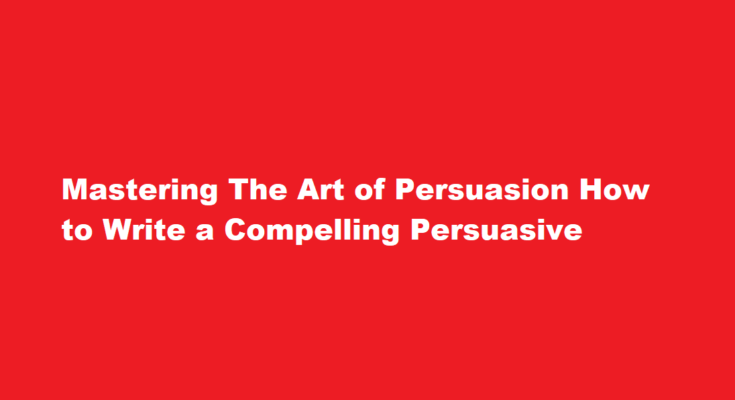Introduction
Persuasive essays are a powerful form of academic writing that allows writers to influence the beliefs and opinions of their readers. Crafting a persuasive essay demands a strategic approach that combines compelling arguments, logical reasoning, and emotional appeal. In this article, we will explore the essential elements of writing an impactful persuasive essay, guiding you through the process step by step.
Choose an Engaging Topic
The first step in writing a persuasive essay is selecting an intriguing and relevant topic. Choose a subject that sparks interest and is likely to provoke debate among your audience. Be sure to research your topic thoroughly and gather credible sources to support your arguments. The more well-informed you are, the more convincing your essay will be.
Understand Your Audience
Before you begin writing, take time to understand your target audience. Consider their values, beliefs, and potential biases. Tailor your persuasive appeals to resonate with your readers’ emotions and experiences. Addressing your audience’s concerns and anticipating their counterarguments will help you present a well-rounded and persuasive case.
Develop a Strong Thesis Statement
Your thesis statement is the heart of your persuasive essay. It should be clear, concise, and assertive, conveying your stance on the topic. Your thesis statement sets the tone for the entire essay and serves as a roadmap for your arguments. Ensure that your thesis statement is arguable and backed by evidence to strengthen your persuasive approach.
Organize Your Arguments
To persuade effectively, organize your essay in a logical manner. Start with a captivating introduction that establishes the context and relevance of your topic. Then, present your main arguments one by one, supporting each with solid evidence, data, or expert opinions. Use transitional phrases to create a smooth flow between paragraphs and guide your readers through your thought process.
Employ Ethos, Pathos, and Logos
The art of persuasion lies in striking a balance between ethos, pathos, and logos. Ethos appeals to credibility and trustworthiness; use reputable sources and present your own authority on the subject matter. Pathos evokes emotions in your readers; tell compelling stories, use vivid language, or create relatable scenarios to elicit empathy. Logos relies on logic and reasoning; present facts, statistics, and logical arguments to reinforce your claims.
Acknowledge Counterarguments
Acknowledge and address opposing viewpoints to demonstrate your awareness of the topic’s complexities. By refuting counter arguments, you strengthen your position and show that your claims can withstand scrutiny. Respectfully dismantle opposing views using logical reasoning and supporting evidence, while emphasizing why your perspective remains more persuasive.
Use Persuasive Language
Craft your language to be clear, concise, and persuasive. Avoid ambiguity and use strong, active verbs to convey conviction. Create vivid imagery with descriptive language to evoke emotions and strengthen your impact. Additionally, employ rhetorical devices like repetition, parallelism, and rhetorical questions to engage your readers and reinforce your message.
Conclude Powerfully
Your conclusion should leave a lasting impression on your readers. Summarize your main points, restate your thesis, and leave them with a compelling call-to-action or thought-provoking statement. The ending should inspire reflection and motivate your audience to take action or reconsider their views.
FREQUENTLY ASKED QUESTIONS
How should I structure a persuasive essay?
When writing a persuasive essay, there is a structure you can follow to help make your argument clear and effective. The essay is typically made up of 3 main sections: the introduction, the body, and the conclusion. To write an effective persuasive essay, each section should contain specific points you want to discuss.
How do you write a persuasive essay in English?
Take some time to find strong supporting evidence. Use paragraphs effectively. Each new element of your argument should start with a new paragraph. Play on the feelings of your audience.
Conclusion
Writing a persuasive essay is both an art and a skill that requires careful planning, effective organization, and persuasive language. By selecting a compelling topic, understanding your audience, developing a strong thesis statement, and employing ethos, pathos, and logos, you can create an impactful essay that sways hearts and minds. Remember to acknowledge counterarguments respectfully and conclude powerfully to leave a lasting impression on your readers. Armed with these essential elements, you are now equipped to master the art of persuasion and craft compelling persuasive essays.
Read Also : A Comprehensive Guide to Painting a Room Like a Pro



